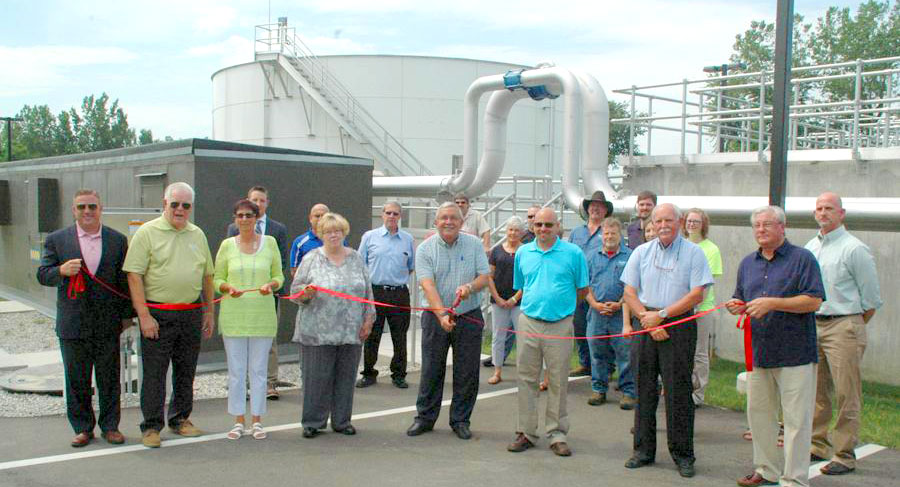District History & Information
DISTRICT INFO
A Brief History of the Lakeland Regional Sewer District

RIBBON CUTTING JULY 21, 2017
Petition to Form District
- Petition to form the LRSD was filed with IDEM in February 2007 by the Kosciusko County Commissioners and Kosciusko County Council
Petition Cited Four Reasons Why the District Was Needed
- Over development of shoreline
- Small lot sizes- over 80% of lots were less that 20K square feet, the minimum required by the County for septic systems
- Poor soils types- rated from poor to severely poor further compounding of density and small lot size
- Flood Plain- over 50% of lots were entirely or partially in the 100-year flood plain.
- The estimated costs assumed a monthly rate of $70 per EDU.
IDEM Order
- Throughout 2007, IDEM toured the proposed District by land and by water to gather facts
- IDEM conducted a public hearing at NWCC in August 2007
- March 14, 2008 issued order to form LRSD, 33 days after the order was issued.
- The order cited that “The residents of the LRSD currently obtain their water for drinking and other purposes from cisterns or individual wells. Contamination from failing septic systems is detrimentally affecting the water quality and public health in the proposed LRSD territory”.
- District officially formed in April 2008-Boundaries- South of Armstrong Road, West of SR 13, North of South Barbee Drive, East of County Road 650E, North of McKenna and CR 400N, and East of CR 475E
- Seven-member board – four appointed by KC Commissioners and three by KC Council
- Initial Board Members- Ron Truex, Bob Sanders, Bob Weaver, Dave Doctor, Stew Lambert, Lowell Gilmore, and Jim Haney
2008-2014 Engineering/Funding
- Evaluated several different engineering proposals and treatment options
- North Webster, Winona Lake, build new WWTP
- Endangered mussels in Tippy River forced us to relocate WWTP adding several million dollars to the cost, 3.5 miles of force main
- Final engineering plan was to use grinders to discharge into a low-pressure system using three pump stations to move waste to the WWTP.
- Estimated rate $70 per month per EDU (single household)
- Settled on USDA Rural Development for funding.
- Spent 5+ years attempting to procure approximately 1,700 easements necessary for the project.
- USDA would not allow us to bid the project until we had all easements and had signed purchase agreements for the proposed WWTP property site and three pump stations property sites.
- Ultimately bypassed 75+ properties that did not sign an easement by putting the main line within the County roadway easement, sometimes under the road. Those properties that were bypassed would not have a grinder installed to service their property.
- Approximately 60 properties were granted exemptions according to Indiana Code. Exemptions are allowed for two conditions (1) large parcel exemption (10 or more acres) and (2) for a septic system that is less than 10 years old and is determined by the County Health Department to be working satisfactorily. Property owners may apply for two additional 5-year exemptions provided the Health Department determines the septic system is still working – total exemption can be 20 years. Fourteen property owners that initially were granted an exemption for systems less than 10 years, rescinded their request prior to the project being put out to bid.
- Late 2014, the project was bid as four different contracts. Lowest bids were substantially higher than anticipated. Based on the project bids, the monthly rate was going to be almost $100 per EDU.
- In January 2015, the LRSD Board voted to pursue funding assistance from USDA in the form of a grant. Members of the Board met with USDA. In addition, we requested assistance from US Congressman Marlin Stutzman and US Senator Joe Donnelly.
- In May 2015, the LRSD Board approved the USDA Letter of Conditions which provided for loans totaling $20.089 million and a grant of $8.629 million.
- In June 2015, the LRSD Board approved a rate ordinance that reflected a monthly rate of $69.95 per EDU
Construction
- July 2015- construction commenced with an anticipated completion date of December 2016.
- Construction included the installation of 1,200+ grinder stations, the electrical panels to operate the grinders, the lateral line from the grinder to the main line, the main lines throughout the District, three pump stations, the forced main to the WWTP and the WWTP.
- Where possible, one grinder was installed to service two properties. Grinders are over 6 feet tall and once installed are at ground level. Cement basins had to be included due to the high ground water levels to keep the grinders from floating out of the ground.
- Construction took slightly longer than expected, however in March 2017, property owners were notified they could begin connecting.
- Property owners were responsible for supplying electrical power to the grinder electrical panel, installing a sewer line from the structure to the grinder, having their septic tank pumped, and having their septic tank abandoned according the County Health Department requirements.
- The District inspected and approved each connection, including the verification that the septic system was properly abandoned.
- Today approximately 1,650 properties are connected. There are 16 properties that have not connected and are being assessed a Failure to Connect Penalty as allowed under Indiana Code.
Other
- Many people and organizations made the project a success. Among them are USDA, the construction contractors Advanced Rehabilitation Technology, Ltd, Robert E. Crosby, Inc., Selge Construction Co., Inc., our engineering firm DLZ, Carson LLP our legal advisors, HJ Umbaugh our rate consultant, Greg Gear our office contractor and the LRSD Board members both past and present.
